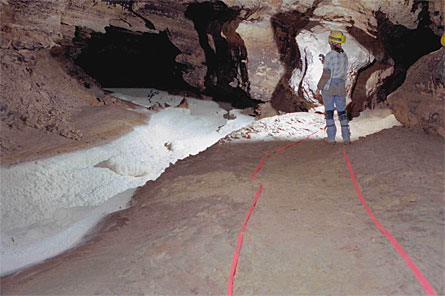PORTLAND, Oregon — Researchers were recently surprised to find that calcite is still accumulating in a kilometers-long, continuous trough of a New Mexico cave that may be the world’s longest cave formation.

The formation’s brilliant white color, as well as its sinuous path through Fort Stanton Cave, near the town of Capitan, has led cavers to dub the feature Snowy River. During recent studies in the cave, scientists found that the typically dry Snowy River occasionally carries water, reported Lewis Land, a geologist at the National Cave and Karst Research Institute in Carlsbad, N.M., during the annual meeting of the Geological Society of America.
The scientists also found that some bits of plastic tape used during previous expeditions to mark off areas of the cave carried a thin dusting of calcite material — a sign the deposit is still growing. Radiometric dating of small samples drilled from the formation bolster that notion, Land reported here October 20 at the annual meeting of the Geological Society of America.
The oldest layers in the formation are less than 850 years old, tests suggest. The sudden appearance of the deposit marked a shift in the amount or direction of subsurface water flow in the area — which, in turn, may denote a sudden change in the region’s climate during the 13th century, says Land.
Land and his colleagues haven’t fully mapped the cave, but known portions of the Snowy River — whose undiscovered reaches extend into yet-unexplored passageways — now extend 7.5 kilometers.






